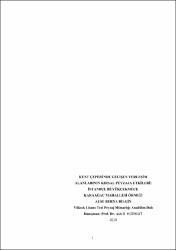| dc.contributor.author | Bilgin, Ayşe Berna | |
| dc.date.accessioned | 2020-09-18T06:50:45Z | |
| dc.date.available | 2020-09-18T06:50:45Z | |
| dc.date.issued | 2019 | |
| dc.identifier.uri | https://hdl.handle.net/20.500.11776/3708 | |
| dc.description.abstract | Metropolitenleşme sürecinde kentlerin dönüşümünün en belirgin özelliği artan yerleşim alanlarıdır. İstanbul metropoliten kentinde son yıllarda görülen kentleşmenin hızlanması, kentin yayılma ihtiyacını doğurmuştur. Kentsel yayılmanın doğal eşikleri baskılamaya başladığı noktada, kent ile kırsal alanlar arasında tampon görevi üstlenen çeper alanlarında kentsel saçak yerleşim alanları ortaya çıkmıştır. Gelişen saçak yerleşim alanlarının çeper alanlarında bulunan kırsal peyzaj alanlarını tehdit ettiği görülmektedir. Karaağaç Mahallesi, Büyükçekmece Gölü içme suyu havzasında yer alan, birkaç yıl öncesine kadar köy statüsünde olan, kırsal niteliklerinin korunması gerekliliği olan bir yerleşim alanıdır. Bu çalışmada; Büyükçekmece Gölü kıyısında bulunan Karaağaç Mahallesi örneğinden yola çıkılarak kentsel yerleşimlerin 2000-2018 yılları arasında kontrolsüz yayılmasının kırsal peyzajlara etkilerinin tespit edilmesi amaçlanmıştır. Araştırma sonucu olarak; Karaağaç Mahallesi idari sınırları içerisinde gelişme gösteren belli başlı 17 adet yerleşim alanı tespit edilmiştir. Çalışma alanındaki yerleşim dokusunun artmasının mahallenin kırsal peyzaj alanlarının yaklaşık %15’inin kaybolmasına sebep olduğu belirlenmiştir | en_US |
| dc.description.abstract | In the metropolitanization process; the most prominent feature of the transformation of cities is the increasing settlement areas. In the metropolitan city of Istanbul, the acceleration of urbanization seen in recent years has caused the need for urban expansion. At the point where urban sprawl begins to suppress natural thresholds; urban fringe settlements emerged in the perimeter areas which act as buffer between the urban and rural areas.It is seen that the developing settlement areas threaten the rural landscape areas located in fringe areas. Karaağaç Neighborhood is a settlement area in the Büyükçekmece Lake drinking water basin, which had the status of a village until a few years ago, and it is necessary to preserve its rural qualities. In this study; The aim of this study is to determine the effects of uncontrolled spread of urban settlements between 2000 and 2018 on rural landscapes based on the sample of Karaağaç Neighborhood on the shores of Lake Büyükçekmece. As a result of the research; The residential areas developed within the administrative boundaries of Karaağaç Neighborhood were identified. It was determined that the increase in the settlement pattern in the study area caused the loss of approximately 15% of the rural landscape areas of the neighborhood. | en_US |
| dc.language.iso | tur | en_US |
| dc.publisher | Namık Kemal Üniversitesi | en_US |
| dc.rights | info:eu-repo/semantics/openAccess | en_US |
| dc.subject | Kırsal Peyzaj | en_US |
| dc.subject | Kentsel Saçaklanma | en_US |
| dc.subject | Kent Çeperi | en_US |
| dc.subject | Karaağaç | en_US |
| dc.subject | Urban Landscape | en_US |
| dc.subject | Urban Sprawl | en_US |
| dc.subject | Urban Fringe | en_US |
| dc.title | Kent çeperinde gelişen yerleşim alanlarının kırsal peyzaja etkileri: İstanbul | en_US |
| dc.title.alternative | THE EFFECTS OF RURAL LANDSCAPE OF THE SETTLEMENT AREAS DEVELOPING IN CITY FRINGE: CASE STUDY OF İSTANBUL BÜYÜKÇEKMECE KARAAĞAÇ NEIGHBORHOOD | en_US |
| dc.type | masterThesis | en_US |
| dc.department | Enstitüler, Fen Bilimleri Enstitüsü, Peyzaj Mimarlığı Ana Bilim Dalı | en_US |
| dc.relation.publicationcategory | Tez | en_US |



















